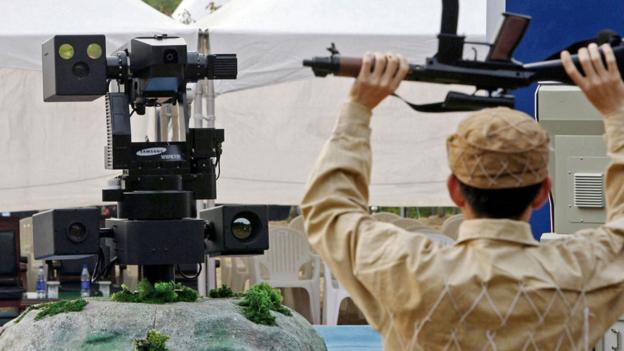21st Century Wire says…
This latest development could give new meaning to the term ‘mindless military’…

Earlier this week, we discussed the ethical, and the legal dilemma, of the roll-out of artificial intelligence through the next generations of drones in the US and Israeli unmanned fleets.
The world is changing, and rapidly. The ‘experts’ are having difficulty adjusting to both technological advances, as well as social advances where societies are beginning to discard the concept, albeit rejecting altogether – the entire premise of modern imperial warfare. Still, the out-dated institutions plough ahead with budgeted programs on anything and everything, traditional as well as newly advanced killing machines…
While the US is weighed down spending fortunes on military industrial pork and other old technologies, it is also burning through its checkbook in R & D and acquisitions of newer applications – all in order to keep ahead of the Chinese Jones’s. According to the Brookings Institute, key emerging technologies in the US military field include:
“new energy systems, such as lasers; new hardware, such as robots and unmanned systems; new manufacturing techniques, including 3-D printing; and new software dealing with cyberwarfare and cybersecurity.”
 But Washington militarist ‘think tanks’ like Brookings are also pushing US military brass towards unmanned, but more “autonomous” technologies:
But Washington militarist ‘think tanks’ like Brookings are also pushing US military brass towards unmanned, but more “autonomous” technologies:
“while present U.S. acquisition focuses on large, often expensive systems designed to directly reproduce how a human would do a task, a more robot-centric or autonomous approach may lead to a different set of design criteria.”
One WP reader issued the stark warning which needs to be discussed now, before AI and robotics dominate our militarised societies. The reality of Cylon and Terminator technologies are here already:
“Robotics might be the future of war but it could also lead to major losses on the battlefield when the enemy invents the counter to it and turns the robots on it’s masters. if you are developing robots you had better be prepared for the hackers who can and will hack the links to those robotic platforms and either disable them nulling your force multiplier. or turning them against you in essence giving them a force multiplier.”
No kidding. And we can hardly afford any of it…

Is the U.S. military ready to embrace new technologies that will define future wars?
Walter Pincus
Washington Post
Is the Air Force’s determination to buy 2,000 F-35 Lightning II joint strike fighters for more than $850 billion comparable to the 1939 efforts by the last chief of the U.S. Cavalry, Maj. Gen. John Knowles Herr, to try to limit the Army’s use of armored units?
“Not one more horse will I give up for a tank,” he said.
The F-35 is “a plane conceived in the 1990s whose massive budget threatens to strangle a new generation of unmanned systems at birth,” wrote the Brookings Institution’s Peter W. Singer in an Oct. 22 Foreign Policy article that calls on the Pentagon “to think big and look to the past in order to prepare for the chaotic technowars of the future.”
The F-35 and the horse cavalry were one of the “eerie parallels” as Singer warned that “not merely tactics or operations, but fundamental organizational questions” are involved. That means the military services have traditionally had a hard time adapting to the emergence of new technologies and new threats to national security.
The Air Force, for example, is faced with redefining its most romantic role, from pilots flying a jet fighter or bomber through enemy fire to reach a target vs. someone safely operating a computer console far away from a war zone and directing an unmanned aircraft to a target.
A September study by Brookings, “Manning the Next Unmanned Air Force,” concluded that the Air Force is “not properly identifying and professionally developing” candidates for careers in the remotely piloted aircraft (RPA) field. Many in the past two years came from the bottom quarter of the Air Force Academy’s academic rolls, while others were taken from among the washouts of initial flight training. One result: Their attrition rate during flight screening “is three times higher than traditional pilots,” the study reported.
Also, “RPA pilots are unable to meet promotion education and training opportunities commensurate with other officers, resulting in a 13 percent lower promotion rate to the rank of major over the last five years,” said the study, which was authored by Col. Brad Hoagland, a command pilot with 23 years of service. He conducted the study as a Brookings military fellow.
Singer points out that the British not only invented the tank but after World War I “carried out a series of innovative tests . . . that showed just how game-changing tanks could be in the next conflict.”
Nonetheless, before World War II the British army retreated from fully adopting armored units “because of the consequences it would have had on the cherished regimental system that was at the center of British military culture.”
Singer should be heard. He has made a career of studying security and technology as director of Brookings’ Center for 21st Century Security and Intelligence. He was appointed to the 2003 U.S. Joint Forces Command’s Transformation Advisory Group and led the Defense Department’s NeXTech project, which explored the implications of emerging technologies…
Continue Washington Post article here
READ MORE DARPA NEWS AT: 21st Century Wire DARPA Files















